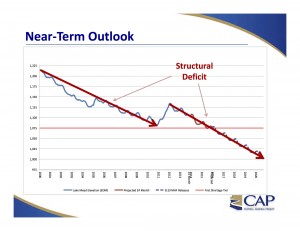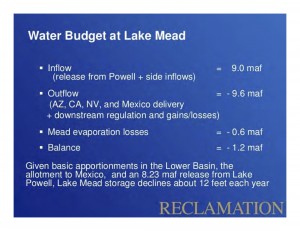update: see also Part II, discussing Arizona’s suggestion regarding what it might take to fix this problem
Absent some big wet years or management intervention, Lake Mead could drop to levels in the next five to eight years that would make it nearly unusable – especially for power generation and water for Las Vegas, but also at some risk for other downstream users – according to a presentation last week by staff at the Central Arizona Project to the agency’s board of directors.
That five-to-eight year time frame is how long it might take, under the scenario sketched by CAP staff, for the surface elevation of Lake Mead to drop to 1,000 feet above sea level – like Four Minutes to Midnight on the Colorado River Doomsday Clock or something. It’s still not midnight, but scary close.
The problem is not drought, though drought makes it harder to dig out of the hole now being created. Rather, it is a “structural deficit,” according to the presentation by the CAP’s Tom McCann and Chuck Collum. The Lower Colorado River Basin’s full legally required allotment each year from the Upper Basin – 8.23 million acre feet – is not enough to meet all the Lower Basin’s water needs. Only with periodic infusions of what I’ve been calling “bonus water” – extra water during unusually wet years – can the Lower Basin make ends meet.
The basic deficit spending math is not new. (See for example Why is Lake Mead Dropping from four years ago or my personal favorite, Hookers and Blow on the Lower Colorado.) What’s new is to hear the analysis of the problem and its dire implications come in the form of a stark public warning from the staff one of the most important water-using agencies in the Lower Basin. This is not some snarky blogger talking. This is coming from the number crunchers at CAP.
I first saw the key math involved in the Lower Basin water budget at a reservoir management meeting in Las Vegas back in the spring of 2010, but the numbers have been around for longer than that. It was a talk by Paul Miller, who then worked for the USBR, and he used exactly the same slide as the one to the left – the slide used in the CAP presentation last week. The math is really simple – a full delivery into Lake Mead is about 9 million acre feet, while evaporation is 0.6 million acre feet and downstream requirements are 9.6 million acre feet.
That’s a 1.2 million acre foot “structural deficit” that’s only made up for when there’s extra water above and beyond the Colorado River Compact’s required deliveries.
That graph at the top shows Lake Mead dropping in 12 out of the last 15 years despite the fact that the big reservoir has gotten its full allotment every single year. That’s the structural deficit.
So what happens if nothing is done and Mead hits 1,000 feet above sea level? A couple of the impacts are the results of physical constraints on the system.
- Regardless of how much water it might be entitled to on paper, Las Vegas has a hard time physically getting its water out of Lake Mead, which supplies ~90 percent of the metro area’s water (though Vegas is hustling to engineer its way out of that problem with a new, deeper intake)
- Generating electricity gets increasingly difficult below 1,050
Beyond that, if nature (in the form of unusually wet years) or the federal government (in the form of intervention to conserve before Mead hits the breaking point) doesn’t intervene, the CAP analysis suggests we’ll be left with what water managers call “run of the river” operations – the only water available each year is the water nature provides. Hoover Dam could be used to smooth out the timing a bit, holding during high flow times of year to deliver water during low flow times of year. But in terms of year-to-year storage, it would be almost like we don’t have a dam at all.
Here’s the full CAP slide deck:



Pingback: What it will take to fix Lake Mead – the Arizona suggestion | jfleck at inkstain
This is the first I’ve read that the Secretary of the Interior could, in effect, override the provisions of the Colorado River Compact. How much authority does the Secretary have?
Steve – It’s a great question for which I don’t have a clear answer. IANAL, but one of the members of my Colorado River law brain trust suggested that there’s a legal argument to be made that Interior has the discretion to act to respond to the low reservoir problem, but that whoever is on the receiving end of that discretion might well disagree with that legal argument and lawyer up. What is clear is that the current legally agreed upon road map, the 2007 shortage sharing agreement, runs out at elevation 1,025, after which no one knows quite what’s going to happen next.
Pingback: Blog round-up: Bloggers weigh in on funding California’s water infrastructure, proposed drought solutions, the BDCP and more, plus will Lake Mead be unusuable in 5 to 8 years? » MAVEN'S NOTEBOOK | MAVEN'S NOTEBOOK
Pingback: Blog round-up: Will the drought extend in 2015? Peter Gleick on solving CA’s water problems, and plotting the Delta Dialogue’s future, plus water conservation, efficiency, groundwater, and more … » MAVEN'S NOTEBOOK | MAVEN'
Pingback: Blog round-up: Will the drought extend in 2015? Peter Gleick on solving CA’s water problems, and plotting the Delta Dialogue’s future, plus water conservation, efficiency, groundwater, a Delta smelt song, and more … » MAVEN'S N
Pingback: Blog round-up: Will the drought extend in 2015? Peter Gleick on solving CA’s water problems, and plotting the Delta Dialogue’s future, plus water conservation, efficiency, groundwater, a Delta smelt song, and more … » MAVEN'S N
Pingback: ATTENTION: Account Past Due | Parting the Waters
Pingback: A mediocre Colorado River Basin forecast | jfleck at inkstain
Pingback: 1080.18: Lake Mead breaks another record, lowest since it was filled | jfleck at inkstain
How low does the water level have to get in Lake Mead before Hoover Dam is forced to go offline?
Angel –
It used to be elevation 1,050 feet, below which you can get water out but couldn’t generate electricity. But the Bureau has been installing new turbines designed to operate at lower levels. I think they go down to 950 feet.
That’s interesting. Thanks for your response…